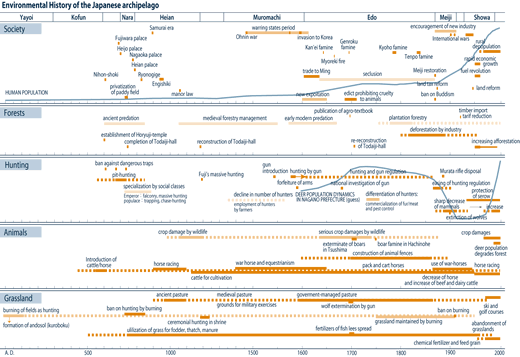A New Cultural and Historical Exploration into Human-Nature Relationships in the Japanese Archipelago
The Japanese Archipelago has been densely populated since the Neolithic Age, and its natural environment has been greatly influenced by human activities. In spite of intensive human intervention in the natural environment, the area is still rich in biota. More recent patterns of interaction between humanity and nature, however, have placed many plants and animals in danger of extinction. This project described the historical evolution of human-nature relationships in the Japanese Archipelago in order to suggest concrete measures for preventing species extinction in the near future.
The Japanese Archipelago has been densely populated since the Neolithic Age, and its natural environment has been greatly influenced by human activities. In spite of intensive human intervention in the natural environment, the area is still rich in biota. More recent patterns of interaction between humanity and nature, however, have placed many plants and animals in danger of extinction.
The main objective of the project was to describe the history of human-nature relationships in the Japanese Archipelago. Project researchers examined how the area's physical environment and biota have changed since the late Paleolithic Age, when human presence was first established. Archaeological, historical and folkloric materials were used to indicate past human perception, knowledge and skills regarding nature in general, and the human effect on key plant and animal species. This combination of biophysical and human cultural history will enrich appreciation of human-environmental history in the archipelago.
Results
In the history of the Japanese Archipelago, there are examples of both long-term sustainability and collapse. The common view that pre-modern or indigenous humans lived in harmony with nature, a harmony disturbed by modern science and technology, is partially true. Human ability to modify nature increased dramatically through time, and the earlier incentives to utilize local bio-resources in a sustainable way were displaced by growing access to global economies and trade. Traditional knowledge does not guarantee sustainable resource utilization, however; traditional systems sometimes have led to over-exploitation of resources. Project research found that the level of community governance plays a critical role in sustainable use of ecosystem services: non-local systems of governance frequently led to collapse. Such findings strengthen the case for enhanced support of community or local governance, especially by the people suffering most from current and future ecosystem service degradation. In some cases, long-term sustainability or recovery from collapse was achieved through collaboration of actors sharing both traditional and scientific knowledge, including, for example, that allowing alignment between local and non-local layers of governance.
Research communication
Project results have been published as Japanese books 35,000 Year History of the Japanese Archipelago (in Japanese, six volumes). Important conclusions and messages were contributed to the report “Satoyama-Satoumi Ecosystem and Human Well-Being: Socioecological Production Landscapes of Japan (Summary for Decision Makers)” for the Convention of Biodiversity (COP10), held in Nagoya, October 2010.


